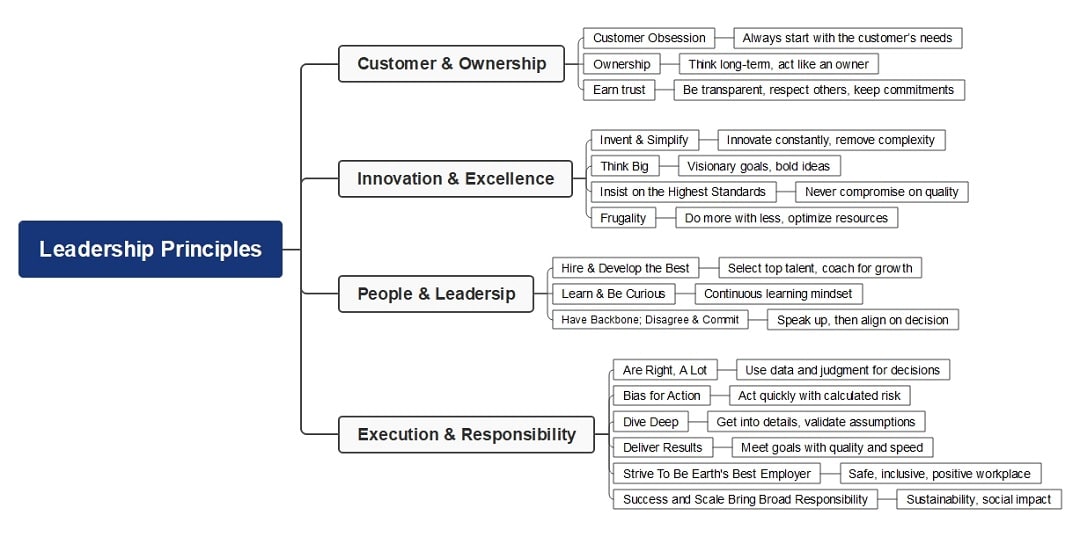Amazon dominates the e-commerce landscape as a trailblazer in online retail, cloud computing, and logistics. Its meteoric rise from a small online bookstore to one of the world's most influential tech giants has been fueled by relentless innovation and expansive reach. As of March 2025, the company has raked in around $650 billion in revenue, underscoring its continued growth.
Amazon’s mission, vision, and core values serve as the backbone of its strategic identity. These statements help the retail giant stay nimble and customer-focused while charting a path ahead of the pack. This article provides a visual breakdown of Amazon’s company statement to make it easy to see how they translate into real-world strategies and competitive advantage.

In this article
Overview of Amazon
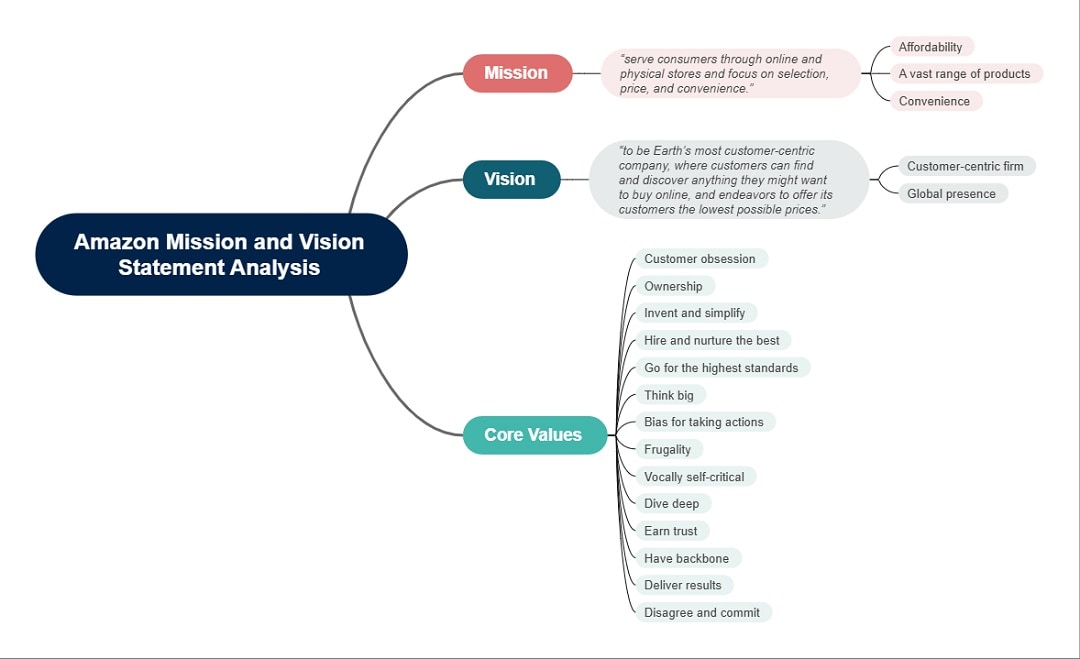
Amazon is a global leader in e-commerce, revolutionizing the way people shop with its vast product selection, fast delivery, and customer-focused services. From its beginnings as an online bookstore to becoming a tech giant, Amazon continues to dominate the digital marketplace through innovation and scale.
Here’s a quick overview of the company:
| Aspect | Information |
| Founded | July 1994 |
| Headquarters | Seattle, Washington |
| Industry classification | Internet retail (e-commerce) |
| CEO | Andy Jassy |
| Annual Revenue (2025) | $168.2 billion USD(Q2 2025) |
| Market Cap | $2.403 trillion USD |
| Latest Growth | 10.87%(Q2 2025) |
| Official Website | amazon.com |
Amazon’s Leadership Principles
Amazon’s core values are encapsulated in its 16 Leadership Principles. These principles serve as the backbone of the company’s decision-making process to create a healthy working environment and ultimately deliver exceptional customer service.
16 Leadership Principles
- Customer Obsession – Start with the customer and work backward.
- Ownership – Act on behalf of the entire company, not just your team.
- Invent and Simplify –Seek out innovation and make things simpler.
- Are Right, A Lot – Good judgment and strong instincts are key.
- Learn and Be Curious – Always seek to improve and explore new possibilities.
- Hire and Develop the Best – Raise the performance bar with every hire and promotion.
- Insist on the Highest Standards – Relentlessly strive for high quality.
- Think Big – Create and communicate a bold direction that inspires results.
- Bias for Action – Speed matters; calculated risk-taking is encouraged.
- Frugality – Accomplish more with less.
- Earn Trust – Build trust with honesty, transparency, and respect.
- Dive Deep – Operate at all levels, stay connected to the details.
- Have Backbone; Disagree and Commit – Respectfully challenge decisions when necessary, then commit fully.
- Deliver Results – Focus on key inputs and deliver with quality and on time.
- Strive to Be Earth’s Best Employer – Create a safer, more diverse, and more inclusive workplace.
- Success and Scale Bring Broad Responsibility – Act with humility and responsibility to society and the planet.
The leadership principles can be grouped into four main themes: Customer and Ownership, Innovation and Excellence, People and Leadership, and Execution and Responsibility. The corresponding mind map based on this grouping is shown below.
Amazon’s Mission Statement
Since its establishment in 1994, Amazon’s mission statement has been revised several times better to convey the core idea of customer focus and convenience. Here is the historical progression of its mission statement:
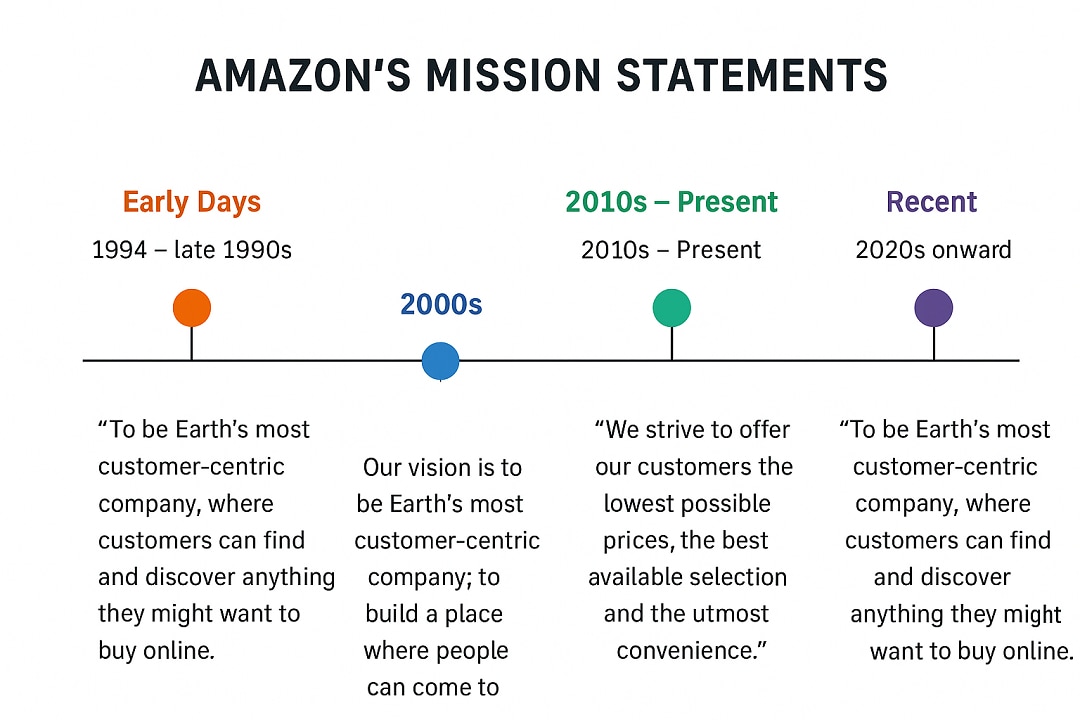
Amazon’s latest mission centers on making customers’ lives better and easier every day. The company continues to emphasize its relentless focus on the customers, aggressive AI and tech innovation, rapid operational execution, and mindful global expansion—boiling down to the goal of “making customers’ lives better every day.”
The following mind map captures the heartof Amazon's current strategic mission:
Amazon’s latest mission message is solid: keep improving life for every customer, relentlessly, through smart tech and independence. However, it can still be clarified to make it more powerful and trustworthy by:
- Adding a unique value to mirror Amazon’s unique purpose beyond convenience.
- Integrating broader societal impact by including aspects about sustainability, inclusivity, and ethical responsibility.
- Defining long-term vision by adding a future-facing element that connects customers, technology, and purpose.
Amazon’s Vision Statement
Unlike the mission, which shifted in tone, Amazon’s vision statement stayed almost the same for 30 years. It’s anchored on customer obsession and being the universal destination for a lot of products. A minor addition is the extra layer of responsibility and innovation in the last decade.
"To be Earth’s most customer-centric company, and to build a place where people can find and discover anything they might want to buy online."
This vision statement stands out for its strong clarity and customer-first focus. By emphasizing its goal to be “Earth’s most customer-centric company,” Amazon reinforces its defining advantage—an unwavering commitment to customer experience. Additionally, the statement’s simplicity makes it easy to understand and communicate, which helps align employees and resonate with customers worldwide.
The main weaknesses of Amazon’s vision statement lie in its limited scope and lack of broader commitments. While it strongly emphasizes being customer-centric, the focus is narrowly confined to customers. It also lacks a forward-looking perspective, offering no clear indication of how Amazon plans to evolve or contribute beyond serving customers. This can be enhanced by:
- Extending beyond online shopping by adding aspects that paint Amazon as a tech-driven solutions leader rather than just an online marketplace.
- Including responsibility and impact through a statement about sustainability, inclusivity, and positive global impact.
How To Create a Company Statement Analysis
Analyzing mission and vision statements isn’t just a corporate formality—it’s a strategic advantage. In the fast-moving e-commerce landscape, these statements reveal what truly drives a company, from its customer-first mindset to its global ambitions. They shape the direction of innovation, pricing, logistics, and every new service Amazon introduces.
Identifying gaps or outdated ideas within these statements can open the door to major opportunities. That’s why visual tools like mind maps make the analysis clearer, more practical, and easier to act on.
The next part will guide you in building a professional mind map with EdrawMind.
Use a Professional Analysis Mind Map Maker
With the constant technological innovation and development, creating an analysis mind map can be automated. You can leverage tools like Wondershare EdrawMind to create your company statement analysis conveniently.

Steps To Make an Analysis Mind Map with EdrawMind
Step 1
Click Create> Blank Mind Map to create a mind map.

Step 2
Then, edit the Main Idea to specify the aspect that you want to analyze. For example, you can use “Leadership Principles.”
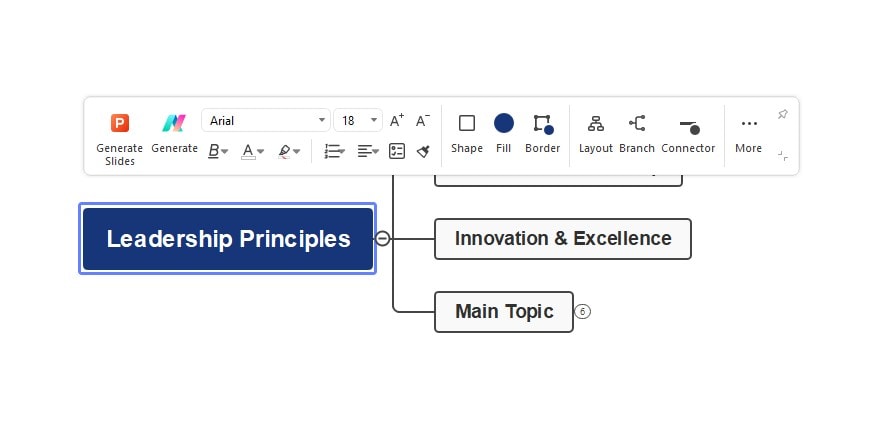
Step 3
Add the main branches to show the main segments of the analysis. To add more main branches, press the Enter key. You can also add subtopics to expand on the idea by pressing the Tab key.
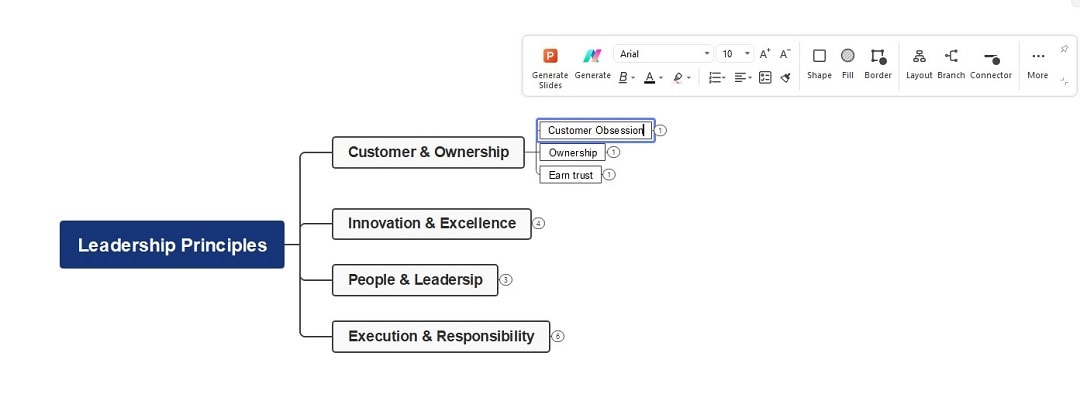
Step 4
Change the theme or layout, or add images or icons to improve your diagram's visual appeal and add more information.
Step 5
Export and share with your friends via PDF, JPG, or other file formats supported by EdrawMind.
Tips When Making an Analysis Mind Map
- Begin with the main idea: Put the mission or vision statement at the center of your mind map. From there, break it into major themes or focus areas (like customer experience, quality, or innovation) for a clear structure.
- Keep it short and simple: Use brief keywords on each branch so the map is easy to read, follow, and expand as you explore the company’s values and strategy.
- Leverage digital tools for efficiency: Platforms like EdrawMind make it easy to design neat, well-organized mind maps. They also offer quick editing, collaboration options, and visual upgrades for better clarity and presentation.
FAQ
-
1. What type of company is Amazon?
Amazon is a global company founded in 1994 by Jeff Bezos. It started as an online bookseller and has evolved into an e-commerce leader that also dabbles in cloud computing (through Amazon Web Services), digital streaming, and AI. -
2. How many employees does Amazon have?
As of 2025, Amazon employs over 1.5 million workers worldwide. -
3. Who is Amazon’s biggest competitor?
Walmart is widely considered Amazon's biggest competitor in e-commerce, especially in the United States, due to its massive network of physical stores for fast delivery and online sales. However, Amazon faces significant competition in various sectors: Alibaba is a major global competitor in e-commerce, especially in China, and Microsoft Azure is the leading rival for Amazon's cloud computing service.




